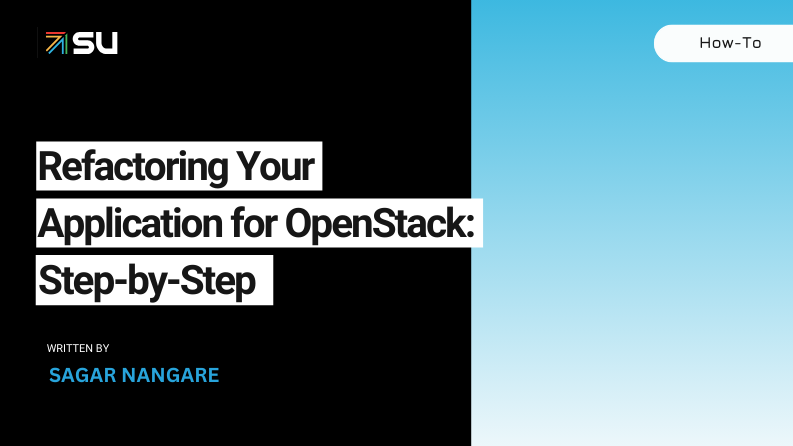As organizations move towards cloud computing platforms like OpenStack, it becomes imperative to adapt and optimize applications to harness the full potential of the cloud. Refactoring is one such method that ensures applications are cloud-ready, enabling them to leverage the cloud-native features of platforms like OpenStack. This article explains what application refactoring is, its importance in the context of OpenStack and outlines the general steps to refactoring your application for this platform.
What Is Application Refactoring?
Code refactoring is the process of restructuring existing software code without changing its external behavior. The goal is to improve the non-functional attributes of the software. This could involve improving the code’s readability, reducing complexity, improving maintainability, and enhancing performance.
Application refactoring is a critical part of the development process. It is a type of essential maintenance, which involves cleaning up the code, removing unnecessary parts, and reorganizing it to make it more efficient and easier to understand for other developers.
In the world of cloud computing, application refactoring becomes even more significant. When migrating applications to the cloud, there is often a need to refactor them to take advantage of new capabilities that were not present in the on-premise environment. Refactoring applications for OpenStack provides numerous benefits: It helps to boost the performance of your applications, improves their scalability, and enhances reliability and availability.
Why Refactor Applications for OpenStack?
OpenStack offers a flexible and scalable environment for applications. However, to harness its full potential, applications need to be optimized. Refactoring is essential for several reasons:
- Optimized performance: OpenStack provides a dynamic environment, and applications that are refactored can utilize resources more efficiently, ensuring faster response times.
- Scalability: Applications that are decoupled and modular can scale more easily in a cloud environment, adapting to increased user loads and data processing needs.
- Cost efficiency: Refactoring can lead to better resource utilization, reducing costs associated with over-provisioning or under-utilizing resources.
- Enhanced security: OpenStack has built-in security features, and refactored applications can better integrate with these features, ensuring a more secure environment.
- Future-proofing: Technologies evolve, and refactoring ensures that the application remains compatible with newer versions or features introduced in OpenStack.
Refactoring Your Application for OpenStack: Step-by-Step
Step 1: Decoupling the Application
When you start the process of application refactoring, the first step is to decouple your application. This means separating its components so that they can function independently without affecting the overall performance of the application.
Decoupling your application allows you to modify and upgrade individual components without disrupting the entire system. It also makes it easier to scale your application, as you can add or remove components as needed without affecting the core functionality.
The process of decoupling involves identifying the different components of your application, such as the database, user interface, and business logic, and separating them into individual modules. This can be a complex task, but with careful planning and execution, you can ensure a smooth transition.
Step 2: Data Management with Cinder or Swift
After decoupling your application, the next step in refactoring for OpenStack is to manage your data. OpenStack offers two main options for data management: Cinder and Swift.
Cinder is a block storage service that allows you to create and manage volumes of data. It’s ideal for applications that require persistent and high-performance storage. Swift is an object storage service that’s perfect for storing and retrieving unstructured data.
Choosing between Cinder and Swift depends on your application’s specific needs. If your application requires fast and reliable access to large amounts of data, Cinder might be the best choice. However, if your application deals with unstructured data like images, audio, and video files, Swift could be a better fit.
Learn more in the Cinder and Swift documentation.
Step 3: Networking with Neutron
Once you’ve managed your data, the next step in refactoring your application for OpenStack is to handle networking. OpenStack’s networking service, Neutron, allows you to create and manage a virtual network for your application.
Neutron provides a range of networking capabilities, including network segmentation, routing, and load balancing. It also supports various networking models, allowing you to choose the one that best fits your application’s needs.
Setting up your network with Neutron involves creating a virtual network, configuring the network settings, and connecting your application to the network. Learn more in the Neutron documentation.
Step 4: Scaling with Heat
As your application grows, it must be able to handle an increasing amount of traffic and data. This is where Heat, OpenStack’s orchestration service, comes in.
Heat allows you to manage the infrastructure of your application, enabling you to scale your application as needed. It does this by creating a template that describes the infrastructure of your application, including the servers, networks, and storage systems.
With Heat, you can easily add or remove resources from your application, ensuring that it can handle varying workloads. It also automates the process of scaling, freeing up your time and resources for other tasks. Learn more about the Heat project documentation.
Step 5: Testing
After you’ve refactored your application for OpenStack, it’s essential to test it thoroughly to ensure that it functions as expected. Testing involves checking each component of your application, from the user interface to the backend systems.
OpenStack provides various tools for testing your application, including Tempest, a set of integration tests that you can use to validate your application’s functionality and performance.
When testing your application, it’s important to test it under different conditions and workloads to ensure that it can handle real-world scenarios. By doing so, you can identify and fix any issues before they affect your users.
Step 6: Go Live
Once you’ve tested your application and are confident that it’s ready, it’s time to go live. This involves deploying your application to a production environment where it can be accessed by your users.
OpenStack provides various tools and services to help you deploy your application, including Nova, a compute service that allows you to manage and control your application’s servers. Learn more in the Nova documentation.
Before going live, it’s important to ensure that your application is fully optimized and that you have a plan in place for monitoring and maintaining it. This includes setting up monitoring tools to track your application’s performance and setting up a backup and recovery plan in case of any issues.
In conclusion, refactoring your application for OpenStack can significantly improve the efficiency of your software development efforts and help you deliver a high-quality application to your users. By following these steps, you can successfully refactor your application and take full advantage of the power of OpenStack.
- Kubernetes Troubleshooting: A Practical Guide - May 21, 2024
- Overview of the OpenStack Documentation - March 18, 2024
- Refactoring Your Application for OpenStack: Step-by-Step - December 27, 2023

)










